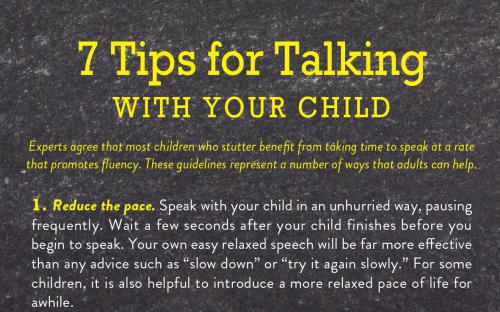
A Blog by Jane Fraser
Year after year, one of the most frequently asked questions we receive, usually from parents of a child who stutters, is a simple one to answer. Do I need to do anything special when talking with a child who stutters? Not really, because what is good advice for the child who stutters is good advice for all children!
That’s why our brochure: 7 Tips for Talking with Your Child is one of our most popular downloads from our website and purchases (by SLPs) from our store every year! Compiled by Barry Guitar, Ph.D., and Edward G. Conture, Ph.D., here they are:
1. Speak with your child in an unhurried way, pausing frequently. Wait a few seconds after your child finishes speaking before you begin to speak. Your own slow, relaxed speech will be far more effective than any criticism or advice such as "slow down" or "try it again slowly."
2. Reduce the number of questions you ask your child. Children speak more freely if they are expressing their own ideas rather than answering an adult's questions. Instead of asking questions, simply comment on what your child has said, thereby letting him know you heard him.
3. Use your facial expressions and other body language to convey to your child that you are listening to the content of her message and not to how she's talking.
4. Set aside a few minutes at a regular time each day when you can give your undivided attention to your child. During this time, let the child choose what he would like to do. Let him direct you in activities and decide himself whether to talk or not. When you talk during this special time, use slow, calm, and relaxed speech, with plenty of pauses. This quiet, calm time can be a confidence-builder for younger children, letting them know that a parent enjoys their company. As the child gets older, it can be a time when the child feels comfortable talking about his feelings and experiences with a parent.
5. Help all members of the family learn to take turns talking and listening. Children, especially those who stutter, find it much easier to talk when there are few interruptions and they have the listeners' attention.
6. Observe the way you interact with your child. Try to increase those times that give your child the message that you are listening to her and she has plenty of time to talk. Try to decrease criticisms, rapid speech patterns, interruptions, and questions.
7. Above all, convey that you accept your child as he is. The most powerful force will be your support of him, whether he stutters or not.
Posted Feb. 3, 2020





 Podcast
Podcast Sign Up
Sign Up Virtual Learning
Virtual Learning Online CEUs
Online CEUs Streaming Video Library
Streaming Video Library